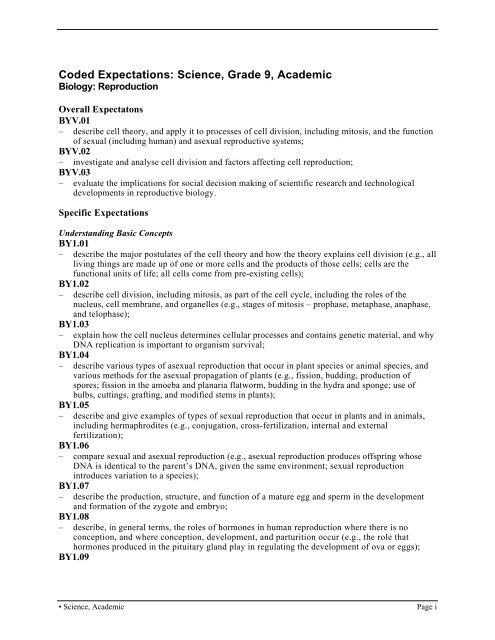Course Profile - Curriculum Services Canada
Course Profile - Curriculum Services Canada
Course Profile - Curriculum Services Canada
You also want an ePaper? Increase the reach of your titles
YUMPU automatically turns print PDFs into web optimized ePapers that Google loves.
Coded Expectations: Science, Grade 9, Academic<br />
Biology: Reproduction<br />
Overall Expectatons<br />
BYV.01<br />
– describe cell theory, and apply it to processes of cell division, including mitosis, and the function<br />
of sexual (including human) and asexual reproductive systems;<br />
BYV.02<br />
– investigate and analyse cell division and factors affecting cell reproduction;<br />
BYV.03<br />
– evaluate the implications for social decision making of scientific research and technological<br />
developments in reproductive biology.<br />
Specific Expectations<br />
Understanding Basic Concepts<br />
BY1.01<br />
– describe the major postulates of the cell theory and how the theory explains cell division (e.g., all<br />
living things are made up of one or more cells and the products of those cells; cells are the<br />
functional units of life; all cells come from pre-existing cells);<br />
BY1.02<br />
– describe cell division, including mitosis, as part of the cell cycle, including the roles of the<br />
nucleus, cell membrane, and organelles (e.g., stages of mitosis – prophase, metaphase, anaphase,<br />
and telophase);<br />
BY1.03<br />
– explain how the cell nucleus determines cellular processes and contains genetic material, and why<br />
DNA replication is important to organism survival;<br />
BY1.04<br />
– describe various types of asexual reproduction that occur in plant species or animal species, and<br />
various methods for the asexual propagation of plants (e.g., fission, budding, production of<br />
spores; fission in the amoeba and planaria flatworm, budding in the hydra and sponge; use of<br />
bulbs, cuttings, grafting, and modified stems in plants);<br />
BY1.05<br />
– describe and give examples of types of sexual reproduction that occur in plants and in animals,<br />
including hermaphrodites (e.g., conjugation, cross-fertilization, internal and external<br />
fertilization);<br />
BY1.06<br />
– compare sexual and asexual reproduction (e.g., asexual reproduction produces offspring whose<br />
DNA is identical to the parent’s DNA, given the same environment; sexual reproduction<br />
introduces variation to a species);<br />
BY1.07<br />
– describe the production, structure, and function of a mature egg and sperm in the development<br />
and formation of the zygote and embryo;<br />
BY1.08<br />
– describe, in general terms, the roles of hormones in human reproduction where there is no<br />
conception, and where conception, development, and parturition occur (e.g., the role that<br />
hormones produced in the pituitary gland play in regulating the development of ova or eggs);<br />
BY1.09<br />
• Science, Academic<br />
Page i

















